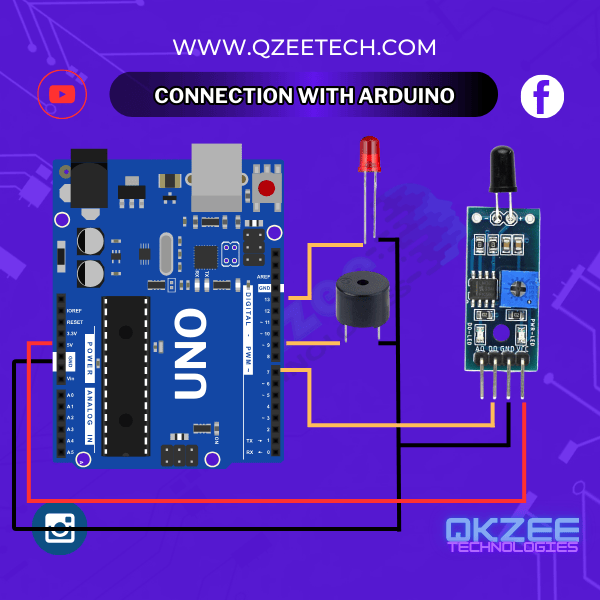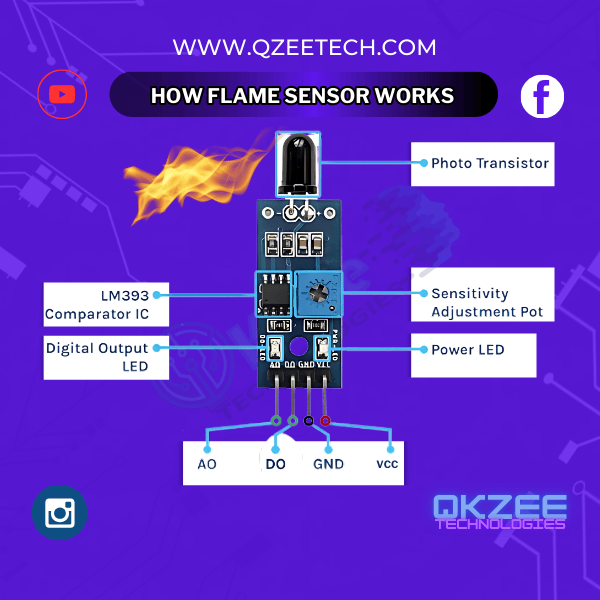Flame Sensor Arduino: How to Use It for Fire Detection

Flame Sensor Arduino: How to Use It for Fire Detection (Complete Guide)
Introduction
Fire detection is crucial for both residential and industrial applications. A flame sensor is a device that detects fire by sensing infrared or ultraviolet light emitted by flames. When combined with an Arduino, it can help create an automated fire detection system. In this guide, we’ll cover everything you need to know about using a flame sensor with Arduino, from wiring and coding to troubleshooting and advanced applications.
Understanding Flame Sensors
Types of Flame Sensors
Infrared (IR) Flame Sensors – Detect infrared radiation emitted by flames.
Ultraviolet (UV) Flame Sensors – Detect UV rays produced by combustion.
Combined UV-IR Sensors – Offer enhanced fire detection by sensing both UV and IR light.
How a Flame Sensor Works
A flame sensor detects specific wavelengths of light emitted by a fire. The sensor module converts this light into an electrical signal, which is then interpreted by a microcontroller such as an Arduino.

Flame Sensor Specifications
Operating Voltage: 3.3V to 5V
Detection Range: 760nm – 1100nm (for IR sensors)
Response Time: Fast response, typically within milliseconds
Detection Angle: 60-120 degrees depending on the sensor type
Choosing the Right Flame Sensor for Arduino
If you need quick response time, use a UV-based flame sensor.
For standard applications, IR flame sensors are cost-effective.
Ensure the sensor’s voltage is compatible with Arduino (typically 5V).
Components Required for Arduino Flame Sensor Project
Arduino Uno (or any compatible board)
Flame Sensor Module
Jumper Wires
LED for Output Indication
Buzzer for Alarm (optional)
Circuit Diagram and Wiring Setup
Connect the Flame Sensor to Arduino:
VCC → 5V on Arduino
GND → GND on Arduino
OUT: Digital Pin 7 on Arduino
Connect an LED (optional) for indication.

Arduino Code for Flame Sensor
int flamePin = 7;
int ledPin = 13;
void setup() {
pinMode(flamePin, INPUT);
pinMode(ledPin, OUTPUT);
Serial.begin(9600);
}
void loop() {
int flameState = digitalRead(flamePin);
if (flameState == LOW) {
digitalWrite(ledPin, HIGH);
Serial.println("Fire detected!");
} else {
digitalWrite(ledPin, LOW);
}
delay(1000);
}
Testing the Flame Sensor with Arduino
Light a small flame (e.g., candle) near the sensor and observe the LED/buzzer.
Adjust the sensitivity using the onboard potentiometer if needed.
Applications of Flame Sensors
Home Fire Alarm Systems
Industrial Fire Detection
Robotic Fire Extinguishers
Troubleshooting Common Issues
Check the wiring and power supply if the sensor isn’t detecting fire.
If false alarms occur, adjust the sensor’s sensitivity.
Can a flame sensor detect all types of flames?
No, most sensors detect visible flames but may not detect certain types of combustion, like smoldering fires.
How far can a flame sensor detect fire?
Detection range varies, but standard IR flame sensors can detect fire up to 1-3 feet away.
Can I use multiple flame sensors with Arduino?
Yes, multiple sensors can be connected to different digital pins for broader coverage.
.
What are the limitations of a flame sensor?
They can be affected by ambient light, infrared sources, and require direct line-of-sight to flames
How do I reduce false alarms in a flame sensor setup?
Adjust sensitivity, shield from external IR sources, and use multiple sensors for accuracy.
Is there a way to use a flame sensor wirelessly?
Yes, you can integrate it with a WiFi module (e.g., ESP8266) for remote monitoring.
Conclusion
Using a flame sensor with Arduino is an effective way to detect fire and enhance safety. With proper wiring, calibration, and coding, you can build a reliable fire detection system for various applications.



